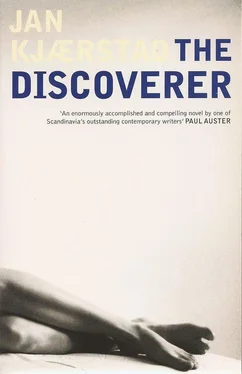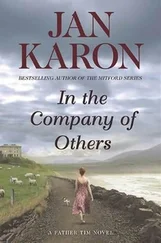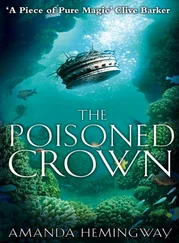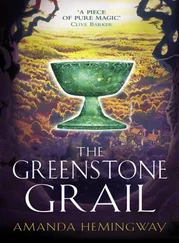Jan Kjaerstad - The Discoverer
Здесь есть возможность читать онлайн «Jan Kjaerstad - The Discoverer» весь текст электронной книги совершенно бесплатно (целиком полную версию без сокращений). В некоторых случаях можно слушать аудио, скачать через торрент в формате fb2 и присутствует краткое содержание. Год выпуска: 2009, Издательство: Arcadia Books, Жанр: Современная проза, на английском языке. Описание произведения, (предисловие) а так же отзывы посетителей доступны на портале библиотеки ЛибКат.
- Название:The Discoverer
- Автор:
- Издательство:Arcadia Books
- Жанр:
- Год:2009
- ISBN:нет данных
- Рейтинг книги:5 / 5. Голосов: 1
-
Избранное:Добавить в избранное
- Отзывы:
-
Ваша оценка:
- 100
- 1
- 2
- 3
- 4
- 5
The Discoverer: краткое содержание, описание и аннотация
Предлагаем к чтению аннотацию, описание, краткое содержание или предисловие (зависит от того, что написал сам автор книги «The Discoverer»). Если вы не нашли необходимую информацию о книге — напишите в комментариях, мы постараемся отыскать её.
The Discoverer — читать онлайн бесплатно полную книгу (весь текст) целиком
Ниже представлен текст книги, разбитый по страницам. Система сохранения места последней прочитанной страницы, позволяет с удобством читать онлайн бесплатно книгу «The Discoverer», без необходимости каждый раз заново искать на чём Вы остановились. Поставьте закладку, и сможете в любой момент перейти на страницу, на которой закончили чтение.
Интервал:
Закладка:
Although she did not know it, Jørgine’s offer could not have come at a better time. Because at that very moment a number of the artists working on the largest decorations for the Town Hall happened to be asking for additional funds, due to the increased cost of materials. And this was a problem, since the estimated budget for the project had already been exceeded. Consequently, when Jonas’s grandmother was invited up to the office of the person in charge, it was with great pleasure that he accepted her generous gift. Jørgine Wergeland’s contribution went into a common fund, but she received a verbal assurance that the lion’s share of the money would be earmarked for Alf Rolfsen’s large, and as yet uncompleted, painting. So although there are no official documents in which it states in black and white that Jørgine Wergeland paid for this mural — on the donations list issued for the inauguration of the Town Hall in 1950 only her name and the tidy sum she contributed are given — she knew, as did the people in charge of the finances and, not least, Alf Rolfsen himself, that she was the one who had paid for the occupation frieze. This was Jørgine Wergeland’s gift to the Norwegian people. The way she saw it, it was also reparation for an act of betrayal, made with German money so to speak.
Staff at the Town Hall soon got used to having an elderly woman with a countenance remarkably similar to that of Winston Churchill popping in to see how the work was coming on and have a chat with the artists, who looked like so many workmen, hard at it on their scaffolding and ladders in hats and spattered overalls, applying paint to the wet plaster. But her keenest interest was reserved, of course, for Alf Rolfsen’s thirty-metre long picture of the occupation years and the way it progressed in a mesmerising zig-zag fashion: men hiding in the forest, the air raid in April, the Gestapo forcing entry to houses, the execution of resistance fighters, underground activities, the men of Milorg, the secret military organisation. Life in the prisoner-of-war camps, liberation. Standing there, looking at the fresco, surrounded by the smell of paint and damp plaster, she remembered the war again, almost every single day of it, and in her mind she quoted the words of her favourite statesman: I was all for war. Now I am all for peace.
As often as possible Jørgine took the opportunity to have elevenses with Alf Rolfsen and his friend Aage Storstein. The latter had just been forced to chip off and repaint the whole of the end wall in the Western gallery because the colours were too pale — painting al fresco was no joke. They usually had their snack in the Festival Gallery, from where they could look down on the Royal Wharf and the Nesodden ferries and across to the Akers Mek shipyard, which Axel Revold had captured, in somewhat abstract fashion, in the now completed fresco on the end wall of the room in which they sat. They were great times, those, also for the two artists, whose discussions on the pitfalls of painting were all the livelier and wittier for having an audience; they frequently ended up sitting there half-an-hour longer than they ought, Rolfsen with his pipe and Jørgine with a Romeo y Julieta, Winston Churchill’s favourite cigar. Alf Rolfsen did most of the talking. Jørgine quickly took a liking to this burly character with the strong face. He was also a wonderful storyteller. Sometimes when they were alone, while he was painting the wall, he would start to tell her, quite unprompted, about his travels: to Athens and the Acropolis, or to Paris where he had met, among others, the Mexican artist Diego Rivera, soon to deck what seemed like acres of his homeland’s wall space with vivid colour. ‘But there’s nothing to beat Rome,’ he confided to Jørgine as she stood there savouring the smells of plaster and pipe tobacco. ‘I saw the frescos of Michelangelo and Raphael at the Vatican. They gave me a whole new conception of the relationship between images and space.’ He climbed down and stepped back a couple of paces. ‘What do you think?’
‘I think you should make that building in the background look more like Victoria Terrasse,’ she said.
It was during these years, on those mid-morning breaks and meanderings among zinc buckets and stepladders, bowls and dishes in these huge studios, that Jørgine Wergeland became an art connoisseur. She was not afraid to put in her own three ha’pence worth now and again either — not only to Rolfson, for whom she felt a particular responsibility, but even to a gentleman as strong-minded as Henrik Sørensen. ‘There’s something wrong with that figure,’ she was liable to shout, motioning with her cigar as she passed underneath the high scaffolding on which he perched like a skyscraper construction worker, working on an oil painting which at that time was reckoned to be the biggest in the world. And sure enough, Sørensen altered that figure.
Jonas’s grandmother was proud of the Town Hall and the works of art it contained, even though they were not, of course, perfect and had, in some cases, an inevitable air of national self-congratulation about them. To her, the Town Hall was not only the city’s indisputable defining symbol, but also a monument to freedom. Just as the Statue of Liberty was the first thing to greet you when you sailed into New York so, at the head of Oslo fjord, you were greeted by the Town Hall. The building and its decorations marked the culmination of an era. The Town Hall in Oslo contained Norway up until the middle of the twentieth century. The very best of the country was reflected in this building, both inside and out, in terms of materials, art and symbols. If the whole of Norway were to be destroyed, bombed, but this building were miraculously to be left standing, it would be possible to reconstruct much of the land’s history right up to the post-war years. Not for nothing did Jonas, influenced as he was by his grandmother, compare the Town Hall, on one occasion, to the information disc about the Earth carried on board the Voyager space probes.
As a way of repaying her, but also because he liked her, Alf Rolfsen used Jørgine Wergeland as the model for a figure in his occupation frieze. She is one of the four women at the pump in the far left of the picture. This was his tribute to her. And no greater tribute could anyone receive: to figure in, for one’s life to be made a part of, a fresco in the country’s most magnificent building. Visitors to the Town Hall today should possibly take a second look at that picture and spare a thought for Jørgine Wergeland. There are, sadly, too few people of her cast.
‘How did you come by all that money?’ Alf Rolfsen once asked her.
‘It’s a secret,’ said Jørgine.
And even to Jonas, her grandchild, this was for a long time a well-kept mystery. He sat alone with his eyes closed, under a blue and white parasol in Montevideo and let the memories wash over him as he listened to the waves breaking on the shore. His thoughts stayed with his grandmother. She might be a vital clue in his search for material, for a kind of television which no one before had dared to imagine. And now and again, perhaps precisely because of the memory of his grandmother’s resolute actions, he was seized by such an acute need to soak up life that he got out of his deckchair and took the bus that ran past the six other white beaches and all the way into the centre of the city, there to stroll, hands behind his back, down the long main street, the Avenida 18 de Julio; taking in the long string of pavement stalls, taking in the countless squares, taking in curious buildings and bombastic statues of dead generals, taking in the people with maté cups and metal straws in their hands and thermoses of hot water under their arms. Montevideo soothed his nerves. In other capitals he constantly felt guilty about all the things he ought to be doing. Montevideo had no famous sights. And what few museums it had were quite liable to be closed, without any explanation. That was fine by Jonas. This city tuned him into a rare, unknown channel. He sauntered along under the indigo veil formed by flowering jacaranda trees, surveying the life on the street, listening, smelling, waiting. An idea, he would give anything for an idea that would provide outlet for the talent he knew he possessed, a flash of inspiration which would also cure this ache in his chest. Later, Jonas would laugh at his own lack of imagination. He kept waiting for a thought to strike him. Instead he met someone.
Читать дальшеИнтервал:
Закладка:
Похожие книги на «The Discoverer»
Представляем Вашему вниманию похожие книги на «The Discoverer» списком для выбора. Мы отобрали схожую по названию и смыслу литературу в надежде предоставить читателям больше вариантов отыскать новые, интересные, ещё непрочитанные произведения.
Обсуждение, отзывы о книге «The Discoverer» и просто собственные мнения читателей. Оставьте ваши комментарии, напишите, что Вы думаете о произведении, его смысле или главных героях. Укажите что конкретно понравилось, а что нет, и почему Вы так считаете.












